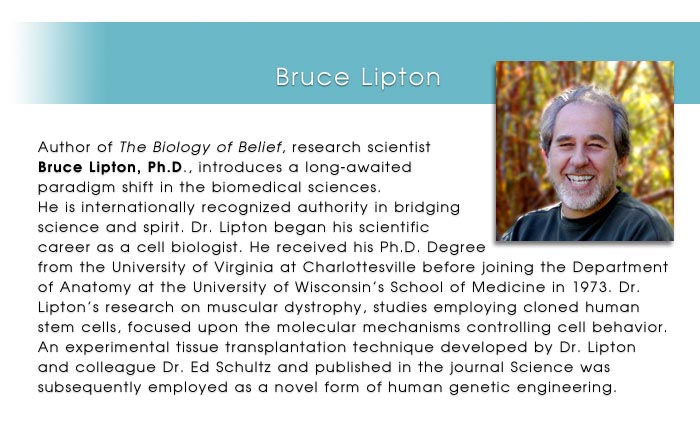
View/Download The Complete Interview
Bruce Lipton
The Impact Of Maternal Emotions On Genetic Development Introduction
What we are finding now is that the physical system (body) is completely changeable – based on the perceptions and the belief system. In prenatal development, the perceptions and beliefs of the fetus is really the same perceptions and beliefs as the mother – and there are very good reasons for it. When you’re developing a new organism, it has to survive in the world that it’s coming into. If a child was born into an environment that is vastly different than former generations, it wouldn’t be able to adapt.
Take five genetically identical seeds and put each seed into a different flower pot with different soil and allow each one to grow in a different environment. If you harvest the seeds from the first generation of each plant you will find that the seeds will be pre-adapted to the environment it developed in. Although genetically identical, within the one generation in different environments the seeds will be pre-adapted to perform in that environment. Nature is brilliant to allow such rapid change because the environment is always changing.
The same holds true for a human. The mother has to pre-implant information about the environment into the child to prepare that child to live in this environment. New research deals with the fact that the genetic structure of an organism can change by the organisms interaction with its environment. Our previous concept was that genes change very little and that when they do, which is called a mutation, that the changes are random, and we considered almost all random mutations hazardous. Now we’re beginning to find that organisms as primitive as bacteria can change their genetic structure to accommodate a stressful environment. It’s necessary for survival. All of a sudden we began looking at the world differently.
Adaptive mutation also recognizes that it isn’t just the environment that produced the change, but it’s the organism’s perception of the environment that determines the type of change that unfolds. This is extremely important, especially in humans.
Lower animal have little room for interpretation. When you get to higher organisms, which have more awareness, a learning bias can insert itself between the real environment and the organism. This bias becomes our perceptions. The higher the learning and awareness the more subjective the learning bias can be.
If a person believes that the environment is hostile, their body will live in a stressful environment even though the real environment may not be hostile. If they perceive it as hostile, then they will change or alter their genetic expression to accommodate their perception. That finding has enormous implications. It’s our perception of the environment that alters our physical patterns. Where do our perceptions come from? Television, school, parents, peers, and everything else around us. The development and health of any offspring is related to the interpretation that offspring makes of the environment and this interpretation may have greater impact on physical processes than the actual environment.
Instead of biophysics, you get quantum biophysics. Quantum biophysics gives you a completely different understanding of the universe and of life and of evolution and of earth than regular biophysics. One of the things that we know in quantum physics is that the observer interacts with their environment by just observing it. Traditional biologists don’t have that understanding. With quantum physics you must recognize that if you’re doing experiments, you’re an observer of your own experiments. You are participating and the observer creates or impacts the world they observe.
A fetus perceives the environment through its mother’s chemistry, it’s mother’s thought fields. Thoughts are electromagnetic fields. The child is being guided by the experiences the mother is having with her environment. The fate of a child is impacted by the mother’s perceptions of her environment. If we recognize this we can find ways to increase the experiences, which give rise to more healthy offspring. Two years ago this would have been only a possibility. Now it’s a certainty.
Our new understanding deals primarily with basic experiments with bacteria. You put bacteria in an environment that’s stressful and they’ll mutate their genes. The mutations are not random. They selectively made mutations to accommodate environmental stresses. If bacteria can do that, humans can do it infinitely better. It is fundamental to survival. Anything in biology that is fundamental to the survival is maintained through the lineage of organisms.
For years it’s been a dogmatic belief that genes switch themselves on. For example, that the cancer gene switched itself on. This is giving a lot of power to the gene. Although there has never been anything in our history of biology where anyone could show how a gene turns itself on. We just believed that. That leads to a dogma in the field called the primacy of DNA. Primacy meaning first cause, the causality of life is due to the DNA. We ascribe to DNA powers which it really doesn’t have. The truth is a gene cannot turn itself on. A cancer gene can’t just say today I’m turning on. As we understand it now, the genes are turned by environmental signals. All the sudden the genes are responsive to the environment. Once you recognize that simple truth, then one must pay attention to the environment because the environment is switching the genes, especially in the earliest stages of development.
View/Download The Complete Interview
Bruce Lipton
